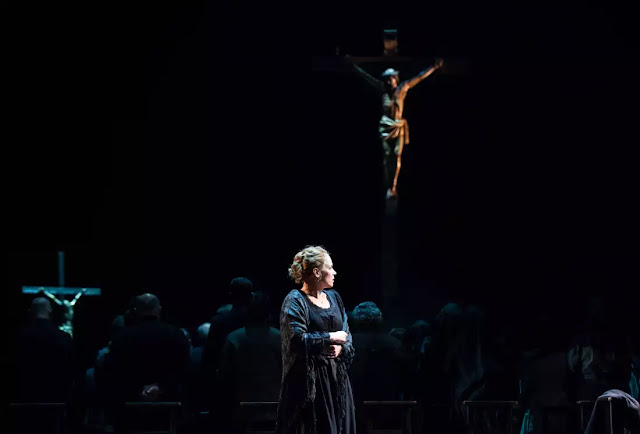Opéra Bastille
 |
| Images: Julien Benhamou /OnP |
Santuzza – Elina Garanča
Turiddu – Yonghoon LeeLucia – Elena Zaremba
Alfio – Vitaliy Bilyy
Lola – Antoinette Dennefeld
Susanna – Anna Caterina
Antonacci
Klementia – Renée MorlocOld Nun – Sylvie Brunet-Grupposo
Maid – Katharina Crespo
Knight – Jeff Esperanza
Mario Martone (director)
Sergio Tramonti (set designs)Ursula Patzak (costumes)
Pasquale Mari (lighting)
Daniela Schiavone (assistant director, Cavalleria rusticana)
Raffaella Giordana (choreography, Sancta Susanna)
Chorus of the Opéra national de Paris (chorus master: José Luis Basso)
Orchestra of the Opéra national de Paris
Carlo Rizzi (conductor)
Two operas: one rather better
known to the operatic public, but neither to me personally. I tried (perhaps
that was the problem?) with Pietro Mascagni’s Cavalleria rusticana, yet felt rather nonplussed. There was nothing
especially to ‘mind’, but the work left little impression beyond its strange
pacing (dragging almost interminably, then abruptly concluding, or at least
finishing). Somehow, it came across both as crude and bland. I heard dashes of
undigested Wagner, devoid of context, washed up amongst mildly Verdian debris. Every
so often, Mascagni seemed to aspire towards Puccini, yet barely left the
starting block, falling time and time again on mere cliché, and failing to
achieve anything of interest melodically, harmonically, orchestrally.
Characterisation seemed minimal, the drama, such as it was, situational. As for
the story, such as it was, would it not have embarrassed a 1980s television
mini-series? I had been curious to discover what the fuss was all about; in a
sense, I am all the more curious now, since I really did not ‘get it’. ‘Some of
my best friends’, but not, alas, me…
If Mascagni’s opera would have
seemed more suited to a ten or fifteen minutes scena, Hindemith’s Sancta
Susanna left me wanting more: always a good sign. The final part of his
Expressionist triptych (Mörder, Hoffnung
der Frauen, and Das Nusch-Nuschi
come first), it is much more my sort of thing, I suppose. Musically, it comes
perhaps as close to ‘atonal’ Schoenberg as Hindemith would ever do: more than
once, I was put in mind of Die glückliche
Hand, even Bluebeard’s Castle, especially in terms of orchestral
colour, but perhaps harmonically too. Subject matter – a convent riven by
sexual frenzy and demonic possession – has certain points of contact with Erwartung, perhaps, and more generally
with other contemporaneous musical explorations (mostly, of course by men) of
female sexuality, but more obviously with Prokofiev’s later Fiery Angel. Hindemith certainly has no
aspirations to the so-called athematicism of Erwartung, though, quasi-autonomous musical form already gesturing,
from within its Expressionist cloak, to the Neue
Sachlichkeit future.
What do the two works have in
common? Very little, I think, although I suppose one might make some generic ‘religious’
claim. Mario Montane, perhaps mistakenly, made little or no effort to link
them. An awkward five minutes or so (following curtain calls!) in between,
house lights still off, did not help, audience members not unreasonably
uncertain what to do (apart, that is, from some Hindemith foes who made a dash
for it). It was not entirely clear to me whether the Cross seen in his Sicilian
Church was supposed to be in some sense the same as that witnessed so
strikingly in Sergio Tramonti’s design for the crypt or other underworld
beneath the convent. At first, Montane’s Cavalleria
rusticana seems highly conventional, but there is a greater degree of
abstraction than one might first guess, much done with comparatively little, rescuing
the work somewhat from its vulgar realism. A definite emphasis upon the
menacing power of the village crowd, seated in judgement, is welcome too. (I
thought of Peter Grimes.) The fun is
really had to be had, though, in Sancta
Susanna. The action initially takes place in a ‘window’, securely embedded,
or so it seems, within a larger structure, which begins to fall to pieces – as,
well, Susanna’s defences do. Nightmarish giant crucifixes, a huge insect (made
up of a highly skilled movement team, well choreographed by Raffaella Giordana),
and the past and present of nuns writhing on the Cross, tread with delicious
ambiguity the line between sympathy and Gothic horror.
 |
The orchestra of the Paris
Opéra sounded sumptuous, with a splendid sheen but plenty of depth in the Hindemith
too. Carlo Rizzi seemed perhaps more at home in Mascagni; I should not have
minded a little more formal delineation in the Hindemith. Nevertheless, his
exploration of orchestral colour there was greatly to be welcomed, and the
climactic moments were viscerally exciting. Choral singing and blocking were
well handled throughout.
Elina Garanča sang beautifully
as Santuzza in the Mascagni, line impeccable, although there was a certain
coldness to her performance that perhaps militated against the possibility of
much emotional involvement. Yonghoon Lee’s excellent Turiddu was quite the
peacock, also quite the mummy’s boy: just, I presume, as he should have been. Dramatic
toing and froing between Anna Caterina Antonacci, every inch the queen of her
stage, and Renée Morloc was gripping, reminding us that there is much to be
pieced together from Hindemith’s vocal lines, not nearly so fragmentary as they
might initially seem. Controlled frenzy was the order of the day, but never too
controlled. All other parts were well taken. If only, though, Sancta Susanna had been presented with a
more appropriate companion piece or pieces, though, whether Hindemith’s own or
something more tellingly related or contrasted. Next time…



